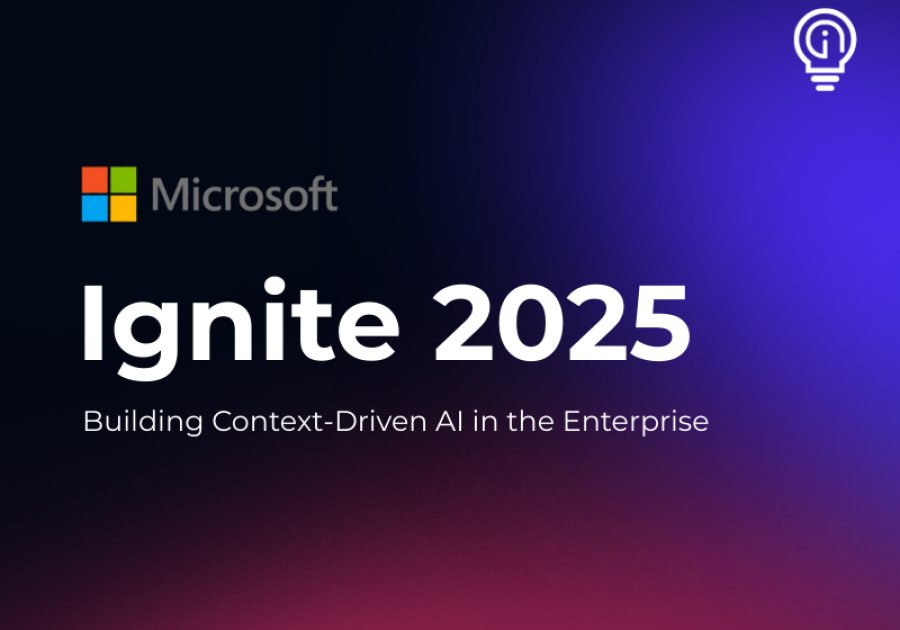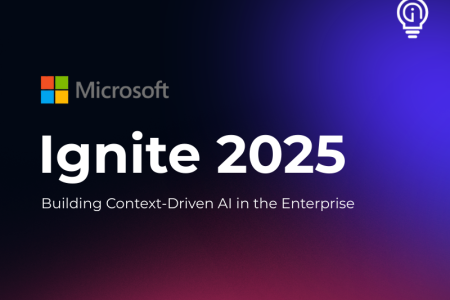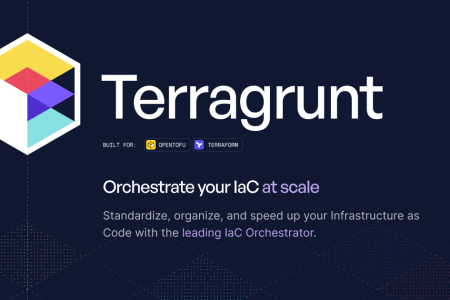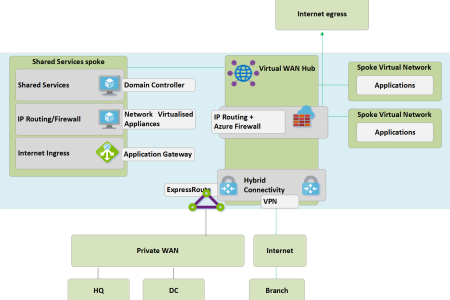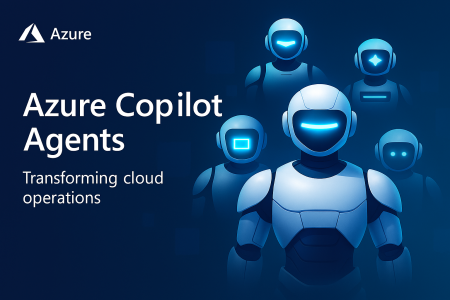TL;DR:
Microsoft Ignite 2025 AI marks a major shift in that AI is no longer a feature but the core operating model for Microsoft-powered enterprises, driven by context-rich knowledge architecture. Success now depends on building and orchestrating context layers across the enterprise, in personal, business, and knowledge, using Microsoft’s IQ stack, Work IQ, Fabric IQ, and Foundry IQ. Most organisations are not yet ready, so the key is to start small with a use-case-driven, incremental roadmap that ties AI initiatives to strategic outcomes, ensuring agents can make decisions with the same intelligence and context as your team.
Table of Contents
"With every platform shift, it redefines how we create. Computing made it personal, Cloud made it connected, and AI makes it ubiquitous. And that is changing how every company needs to operate."
Judson Althoff, CEO, Microsoft Commercial Business
In the opening keynote at Ignite 2025, Microsoft delivered a definitive mandate: The era of AI as a feature is over. AI has become the non-negotiable, structural operating model for the Microsoft-powered enterprise, underpinned by relevant, high-fidelity context.
This shift compels organisations to rethink their knowledge architecture strategies. The new competitive frontier is defined not by who has the largest and best mined data lake, but by who can best architect and govern that data to fuel AI-driven operations.
The Architecture of Ubiquitous AI
By stating that “AI makes it ubiquitous,” Judson Althoff highlights a fundamental shift: AI has evolved from a specialised capability into an enterprise-wide operating expectation.
Merriam-Webster defines ‘ubiquitous’ as “existing or being everywhere at the same time : constantly encountered : widespread. For example – A company’s ads are ubiquitous.”
Microsoft’s ads about AI certainly fit that description, and have for some time, so a Microsoft executive simply announcing “more AI” would not be news.
However, Ignite 2025 was not “more AI.” Microsoft didn’t simply announce new features at Ignite 2025 – they declared a platform paradigm shift. Ignite 2025 repositioned AI as the foundation of the entire Microsoft ecosystem, moving from building towards AI to building the enterprise on top of AI. In other words, the entire Microsoft ecosystem is being repositioned around AI-first operations.
"AI in the flow of human ambition, ubiquitous innovation, observability at every layer of the stack, all on the fundamental building blocks of intelligence and trust, empowered by Work IQ, Foundry I, and Fabric IQ."
Judson Althoff, CEO, Microsoft Commercial Business

The Three-Tier IQ Architecture:
Microsoft introduced a complete knowledge stack where three intelligence layers work together to power AI-native operations in the Microsoft ecosystem:
1. Work IQ - The personal context layer.
Work IQ understands you, your role and your organisation by continuously learning from your M365 files, messages, work habits and preferences. Built into Microsoft 365 as a foundational service, not a connector or application, running in memory alongside your work using your data to actively make inferences about your intent and relationships.
2. Fabric IQ – The business logic layer.
Fabric IQ unifies enterprise data through a shared business model built for AI, drawing on 20 million Power BI semantic models. The goal is to enable agents to monitor real-time signals in a Microsoft-powered environment and respond to changing conditions across your enterprise by understanding entities, relationships and business rules consistently.
3. Foundry IQ - The knowledge orchestration layer.
Foundry IQ provides a secure, unified repository for agent knowledge with automatic indexing and document structure handling. It connects diverse data sources such as SharePoint, Fabric IQ, OneLake, Azure Storage and web sources through a single, unified interface. In the context of this blog, its core is orchestrating knowledge retrieval across all relevant sources to provide agents with comprehensive and tailored context.
In summary: Work IQ supplies personal and organisational context, Fabric IQ provides business intelligence and operational state, and Foundry IQ brings them all together to enable agents to plan, reason and iterate with your personal and organisational context.
Context is the Missing Link in AI
"The fundamental building blocks of AI need to know how you work, with whom you work, the content over which you reason."
Judson Althoff, CEO, Microsoft Commercial Business
At this point, I’ve peppered the word “context” over half a dozen times without explaining it. In an AI-native operating model, context is all the relevant, surrounding information and background knowledge that an AI system uses to accurately comprehend inputs, resolve ambiguities and generate appropriate, meaningful responses or actions.

Why is Context Imperative?
Here’s the deeper insight Microsoft revealed at Ignite 2025: The problem isn’t that AI agents lack intelligence — it’s that they lack your intelligence.
Large language models already possess reasoning capabilities that can match or exceed human performance on many tasks. What they fundamentally lack is access to the specific information, relationships, and reasoning patterns that define “how you work, with whom you work, and the content over which you reason.”
The Limitation of Connectors vs. Work IQ
Consider the core limitation described in the keynote:
“Work IQ works across all of your data in real time and has full context, which allows you to find patterns and insights. While connectors only pull fragments of the data with no real understanding of the context, which means they can miss critical information, they can ignore relationships and give incomplete answers.”
This isn’t about making agents smarter — it’s about giving them the same context you have. When a colleague reaches out with a question, they have the same context you do because they share organisational memory, understand relationships, and know the history of decisions. Agents need this too.
The Context Gap is the Intelligence Gap
- Without Work IQ: The agent doesn’t know your role, your preferences, your work patterns or your organisational relationships
- Without Fabric IQ: The agent can’t understand business logic, operational state or how core concepts are defined and relate across your enterprise
- Without Foundry IQ: The agent can’t “reason through context” by planning, iterating and retrieving across your complete knowledge landscape
Microsoft’s argument is profound: If agents had complete, high-fidelity context – if they could “see across silos, reason through context and act on behalf of people” – they would make the same decisions you would, or help you make demonstrably better ones. The intelligence is there. The context is not.
This is why Ignite 2025 announces Work IQ, Fabric IQ, and Foundry IQ as the “fundamental building blocks that embody context and intelligence”. Notice of intelligence itself. Context is intelligence when applied to action.

The Uncomfortable Reality: AI Is Already in Your Stack
Here’s what Microsoft isn’t saying directly: AI is already embedded in your Microsoft stack whether you’re ready or not. Work IQ is running in M365. Copilot is included with your licenses. Your team has access to thousands of models in AI Foundry.
The question isn’t “Is it okay to give AI our context?” That ship has sailed. AI is already using your context right now.
The question is “How do we ensure the AI already operating in our environment has the context we want it to have?”
Or alternatively “How do make the most out of the AI we have access to and the context it has access to?”
This may create an uncomfortable position for your enterprise if any of the following are true:
- You’re still implementing the Azure Ignite announcements from 2020.
- You’re still migrating workloads to Azure.
- You haven’t finished your SharePoint, Dataverse, Power Platform data governance framework.
- Your data is still siloed across SharePoint sites, file shares and legacy systems.
- You don’t have a concept of semantic models, let alone 20 million of them.
And now Microsoft is telling you that agents need comprehensive context architecture to be useful and safe, and that context architecture is now baked into the core Microsoft ecosystem. That’s a lot to catch up on. All those ‘tomorrow problems’ seem to have arrived today and all at once.
Building AI-Ready Knowledge Architecture
Unfortunately, effective AI knowledge architecture doesn’t emerge from announcements – it’s built on foundations many enterprises haven’t finished laying.
The architecture Microsoft describes, where the foundation blocks of intelligence seamlessly orchestrate context across your enterprise, requires combining AI models, unified data platforms, and sophisticated orchestration patterns to enable intelligent, context-aware and scalable solutions.
What that actually requires at minimum is:
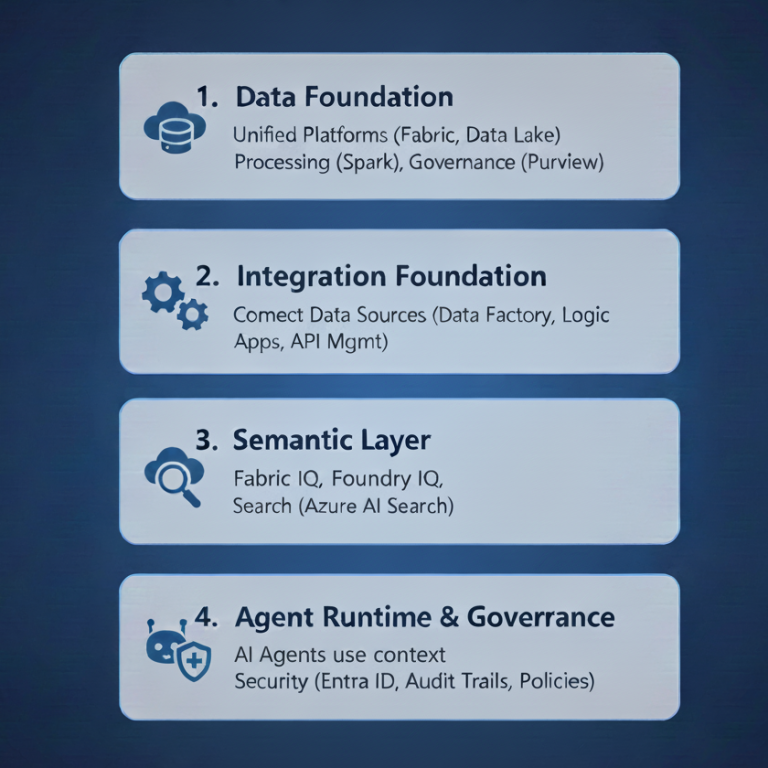
1. Data Foundation: Unified data platforms, like Microsoft Fabric and Azure Data Lake Storage for ingestion, transformation and governance. Apache Spark runtimes in Fabric or Databricks enable large-scale feature engineering and model training. Purview provides data classification, labeling and lineage tracking. OneLake creates a unified namespace across disparate sources.
2. Integration Foundation: The ability to connect and integrate diverse data sources across your enterprise requires robust integration services which means implementing the underlying Azure integration stack. Services like Azure Data Factory, Logic Apps and API Management enable the connectivity that makes unified context possible.
3. Semantic and Knowledge Layer: This is where Fabric IQ and Foundry IQ operate. Fabric IQ translates integrated data into business-meaningful semantic models – the Power BI models that define entities, relationships, and business logic. Foundry IQ provides the knowledge orchestration – connecting SharePoint, OneLake, Azure Storage, and external sources with vector search capabilities built on Azure AI Search to support semantic retrieval in RAG systems.
4. Agent Runtime and Governance Layer: Finally, agents consume context from Work IQ (personal), Fabric IQ (business), and Foundry IQ (knowledge) to take action on your behalf. These agents – whether built on Azure OpenAI Service, custom frameworks using AI Foundry or Copilot Studio – require identity from Entra ID and governance. This layer ensures agents can authenticate, access appropriate context based on role-based permissions, maintain audit trails, and operate within organisational policies while executing workflows, automating decisions and orchestrating tasks across your enterprise.
Why AI Projects Often Fail Without a Roadmap
For enterprises still migrating basic workloads to Azure, still establishing information protection and governance, or still consolidating on-premises and cloud data sources, the distance from “current state” to “context-ready knowledge architecture” isn’t just months – it’s layers of foundational work that could take years.
This is why most AI projects fail. A pattern we’ve seen repeatedly and talked about in our blog on how to escape the AI Graveyard: organisations spin up AI proof-of-concepts (POCs), experiment with agents, test Copilot scenarios – and then nothing.
One of the reasons we discuss in our escape from the AI Graveyard is because the POCs are not part of a broader strategic alignment that is translated into an actionable roadmap. Your enterprise needs a roadmap that has concrete plans in use case terms for building knowledge architecture and intelligent agents over time.
Use case and AI strategy should be tightly coupled. We talk more about this in our blog on AI Strategy and linking use case to strategy as your very first step to ensure that AI efforts aren’t just treated as standalone experiments, but are meaningfully connected to long-term goals.

Use Case Driven Incremental Roadmap and Enterprise Architecture
Basically, baby steps that build up.
Instead of designing the perfect knowledge architecture upfront, start with a core organisational problem and build only the context layers that problem requires and along the way find opportunities to design and expand your foundation.
Real-World Example: A Homegrown Steel Company
I have been working with a couple of great blokes at a homegrown steel company for some time now. They were interested in AI and already had a vision. Their grand goals were tied to their Microsoft Finance and eCommerce ERP platform and core manufacturing digital transformation.
My friends also had a pressing issue with one of their critical integrations. So, we started there by solving a simple problem of how to solve for the myriad permutations within that integration and changes in the upstream API and we used the Azure AI stack to solve it by generating synthetic data to match their business scenarios and building automated testing pipelines.
But they didn’t stop there. Together we answered, “where can we go from here”. We laid out an incremental roadmap for data and integration foundations, knowledge architecture and AI agents that would eventually support their broader strategic goals. Each step was small but real. Each phase was both use case and groundwork for the next.
The Context Imperative
Microsoft Ignite 2025 made one thing clear: AI isn’t optional infrastructure anymore – it’s already running in your Microsoft stack and it needs your context to be effective.
The question isn’t whether to build knowledge architecture. It’s how to get there, which problem you’ll solve first and what foundation you’ll build along the way.
The enterprises that act now will be the ones prepared for the AI-native future Microsoft is already shaping.

